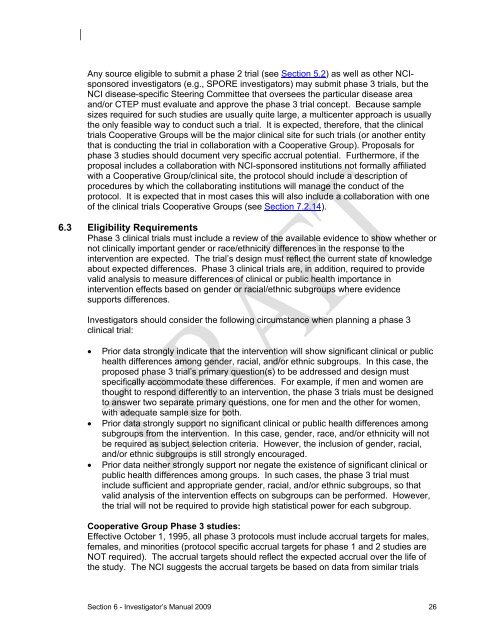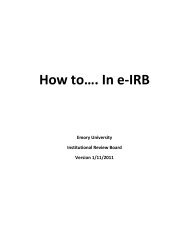A Manual for Participants in Clinical Trials of Investigational Agents ...
A Manual for Participants in Clinical Trials of Investigational Agents ...
A Manual for Participants in Clinical Trials of Investigational Agents ...
You also want an ePaper? Increase the reach of your titles
YUMPU automatically turns print PDFs into web optimized ePapers that Google loves.
Any source eligible to submit a phase 2 trial (see Section 5.2) as well as other NCIsponsored<br />
<strong>in</strong>vestigators (e.g., SPORE <strong>in</strong>vestigators) may submit phase 3 trials, but the<br />
NCI disease-specific Steer<strong>in</strong>g Committee that oversees the particular disease area<br />
and/or CTEP must evaluate and approve the phase 3 trial concept. Because sample<br />
sizes required <strong>for</strong> such studies are usually quite large, a multicenter approach is usually<br />
the only feasible way to conduct such a trial. It is expected, there<strong>for</strong>e, that the cl<strong>in</strong>ical<br />
trials Cooperative Groups will be the major cl<strong>in</strong>ical site <strong>for</strong> such trials (or another entity<br />
that is conduct<strong>in</strong>g the trial <strong>in</strong> collaboration with a Cooperative Group). Proposals <strong>for</strong><br />
phase 3 studies should document very specific accrual potential. Furthermore, if the<br />
proposal <strong>in</strong>cludes a collaboration with NCI-sponsored <strong>in</strong>stitutions not <strong>for</strong>mally affiliated<br />
with a Cooperative Group/cl<strong>in</strong>ical site, the protocol should <strong>in</strong>clude a description <strong>of</strong><br />
procedures by which the collaborat<strong>in</strong>g <strong>in</strong>stitutions will manage the conduct <strong>of</strong> the<br />
protocol. It is expected that <strong>in</strong> most cases this will also <strong>in</strong>clude a collaboration with one<br />
<strong>of</strong> the cl<strong>in</strong>ical trials Cooperative Groups (see Section 7.2.14).<br />
6.3 Eligibility Requirements<br />
Phase 3 cl<strong>in</strong>ical trials must <strong>in</strong>clude a review <strong>of</strong> the available evidence to show whether or<br />
not cl<strong>in</strong>ically important gender or race/ethnicity differences <strong>in</strong> the response to the<br />
<strong>in</strong>tervention are expected. The trial’s design must reflect the current state <strong>of</strong> knowledge<br />
about expected differences. Phase 3 cl<strong>in</strong>ical trials are, <strong>in</strong> addition, required to provide<br />
valid analysis to measure differences <strong>of</strong> cl<strong>in</strong>ical or public health importance <strong>in</strong><br />
<strong>in</strong>tervention effects based on gender or racial/ethnic subgroups where evidence<br />
supports differences.<br />
Investigators should consider the follow<strong>in</strong>g circumstance when plann<strong>in</strong>g a phase 3<br />
cl<strong>in</strong>ical trial:<br />
• Prior data strongly <strong>in</strong>dicate that the <strong>in</strong>tervention will show significant cl<strong>in</strong>ical or public<br />
health differences among gender, racial, and/or ethnic subgroups. In this case, the<br />
proposed phase 3 trial’s primary question(s) to be addressed and design must<br />
specifically accommodate these differences. For example, if men and women are<br />
thought to respond differently to an <strong>in</strong>tervention, the phase 3 trials must be designed<br />
to answer two separate primary questions, one <strong>for</strong> men and the other <strong>for</strong> women,<br />
with adequate sample size <strong>for</strong> both.<br />
• Prior data strongly support no significant cl<strong>in</strong>ical or public health differences among<br />
subgroups from the <strong>in</strong>tervention. In this case, gender, race, and/or ethnicity will not<br />
be required as subject selection criteria. However, the <strong>in</strong>clusion <strong>of</strong> gender, racial,<br />
and/or ethnic subgroups is still strongly encouraged.<br />
• Prior data neither strongly support nor negate the existence <strong>of</strong> significant cl<strong>in</strong>ical or<br />
public health differences among groups. In such cases, the phase 3 trial must<br />
<strong>in</strong>clude sufficient and appropriate gender, racial, and/or ethnic subgroups, so that<br />
valid analysis <strong>of</strong> the <strong>in</strong>tervention effects on subgroups can be per<strong>for</strong>med. However,<br />
the trial will not be required to provide high statistical power <strong>for</strong> each subgroup.<br />
Cooperative Group Phase 3 studies:<br />
Effective October 1, 1995, all phase 3 protocols must <strong>in</strong>clude accrual targets <strong>for</strong> males,<br />
females, and m<strong>in</strong>orities (protocol specific accrual targets <strong>for</strong> phase 1 and 2 studies are<br />
NOT required). The accrual targets should reflect the expected accrual over the life <strong>of</strong><br />
the study. The NCI suggests the accrual targets be based on data from similar trials<br />
Section 6 - Investigator’s <strong>Manual</strong> 2009 26




